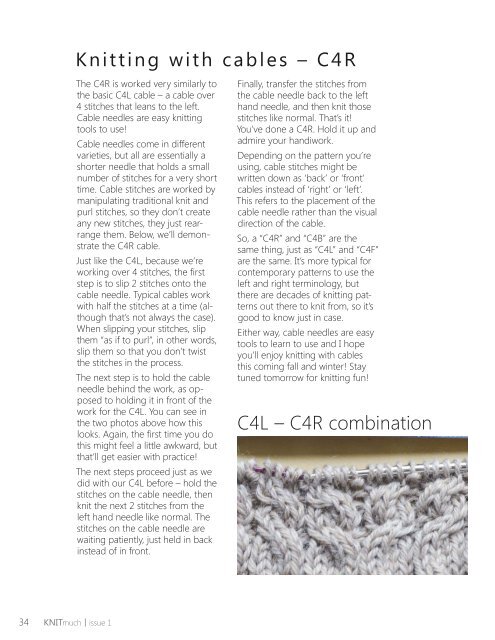KNITmuch | Issue 01
Here it is! The much anticipated FREE Premiere issue of KNITmuch Magazine! We’re extremely excited to launch this first issue featuring a full 52 pages of knitting projects, tips, techniques, and products. In this issue, you’ll find a review of the NEW Downton Abbey Yarn Collection and the irresistible Top This! yarn kit. See the Crawley Vest and Budding Romance Shawl patterns for great project ideas using the new Downton Abbey yarns. We also review a variety of project ideas to make with Red Heart’s Cutie Pie and Sashay yarns. We go back to knitting basics to inspire new knitters to expand their knowledge of knitting and get to the bottom of key technical knitting terms and skills. Enjoy exploring our very first issue. Save it in your favorites, share it with your knitting friends!
Here it is! The much anticipated FREE Premiere issue of KNITmuch Magazine! We’re extremely excited to launch this first issue featuring a full 52 pages of knitting projects, tips, techniques, and products.
In this issue, you’ll find a review of the NEW Downton Abbey Yarn Collection and the irresistible Top This! yarn kit. See the Crawley Vest and Budding Romance Shawl patterns for great project ideas using the new Downton Abbey yarns. We also review a variety of project ideas to make with Red Heart’s Cutie Pie and Sashay yarns. We go back to knitting basics to inspire new knitters to expand their knowledge of knitting and get to the bottom of key technical knitting terms and skills.
Enjoy exploring our very first issue. Save it in your favorites, share it with your knitting friends!
Create successful ePaper yourself
Turn your PDF publications into a flip-book with our unique Google optimized e-Paper software.
Knitting with cables – C4R<br />
The C4R is worked very similarly to<br />
the basic C4L cable – a cable over<br />
4 stitches that leans to the left.<br />
Cable needles are easy knitting<br />
tools to use!<br />
Cable needles come in different<br />
varieties, but all are essentially a<br />
shorter needle that holds a small<br />
number of stitches for a very short<br />
time. Cable stitches are worked by<br />
manipulating traditional knit and<br />
purl stitches, so they don’t create<br />
any new stitches, they just rearrange<br />
them. Below, we’ll demonstrate<br />
the C4R cable.<br />
Just like the C4L, because we’re<br />
working over 4 stitches, the first<br />
step is to slip 2 stitches onto the<br />
cable needle. Typical cables work<br />
with half the stitches at a time (although<br />
that’s not always the case).<br />
When slipping your stitches, slip<br />
them “as if to purl”, in other words,<br />
slip them so that you don’t twist<br />
the stitches in the process.<br />
The next step is to hold the cable<br />
needle behind the work, as opposed<br />
to holding it in front of the<br />
work for the C4L. You can see in<br />
the two photos above how this<br />
looks. Again, the first time you do<br />
this might feel a little awkward, but<br />
that’ll get easier with practice!<br />
The next steps proceed just as we<br />
did with our C4L before – hold the<br />
stitches on the cable needle, then<br />
knit the next 2 stitches from the<br />
left hand needle like normal. The<br />
stitches on the cable needle are<br />
waiting patiently, just held in back<br />
instead of in front.<br />
Finally, transfer the stitches from<br />
the cable needle back to the left<br />
hand needle, and then knit those<br />
stitches like normal. That’s it!<br />
You’ve done a C4R. Hold it up and<br />
admire your handiwork.<br />
Depending on the pattern you’re<br />
using, cable stitches might be<br />
written down as ‘back’ or ‘front’<br />
cables instead of ‘right’ or ‘left’.<br />
This refers to the placement of the<br />
cable needle rather than the visual<br />
direction of the cable.<br />
So, a “C4R” and “C4B” are the<br />
same thing, just as “C4L” and “C4F”<br />
are the same. It’s more typical for<br />
contemporary patterns to use the<br />
left and right terminology, but<br />
there are decades of knitting patterns<br />
out there to knit from, so it’s<br />
good to know just in case.<br />
Either way, cable needles are easy<br />
tools to learn to use and I hope<br />
you’ll enjoy knitting with cables<br />
this coming fall and winter! Stay<br />
tuned tomorrow for knitting fun!<br />
C4L – C4R combination<br />
34 <strong>KNITmuch</strong> | issue 1

















